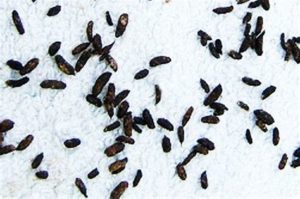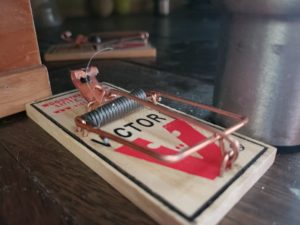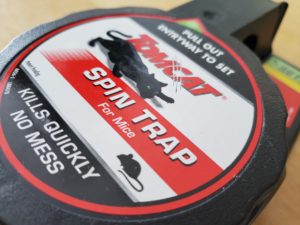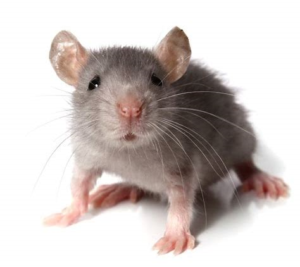 It took only 10 days of being absent to be invaded. That seems like such a short time for nature to crawl in and take over. But that’s all it took.
It took only 10 days of being absent to be invaded. That seems like such a short time for nature to crawl in and take over. But that’s all it took.
I opened the pantry door and was immediately struck by the smell, a musty funk that I’m certain wasn’t there when I left. I paused taking it in despite its ability to scrunch and contort my face all on its own. I lingered there trying to identify it. Then I noticed them. Small pellets scattered on the shelves and immediately identified the funk, as mouse excrement. By the looks of it, an army had invaded my pantry in the 10 days that I was gone on a fishing trip.
I closed the closet door quickly. An act that was, at best, a feeble attempt to simply make it “go away,” but it didn’t. I reopened the door pensively, paused, and decided to call in the big gun, my husband. A hunter angler who grew up on an 8000-acre ranch, he was better equipped to deal with this than me. He assessed the situation and immediately took actions to eradicate the problem. First a quick trip to Home Depot to purchase traps. Then, strategic placement of the traps, disguised as little peanut butter havens, throughout the pantry. My heart dropped. Mouse traps are rather raw and to the point. They look like mini torture devised that would be found in 16th century dungeons or used during the Inquisition. What about “catch and release” – for mice?
 Later that evening preparing for bed I opened the cabinet under the sink in my bathroom. Mouse poop, and a lot of it! The invasion was deeper than I imagined. The kitchen pantry is an obvious. It’s filled with crackers, flour, cereal, snack bars (although the mice seemed to prefer the bags of straight sugar more than anything else – these mice were hard core). But bathrooms contain no food. This was serious. I now feared for my life and my home. Another call out to the big gun and additional traps were set.
Later that evening preparing for bed I opened the cabinet under the sink in my bathroom. Mouse poop, and a lot of it! The invasion was deeper than I imagined. The kitchen pantry is an obvious. It’s filled with crackers, flour, cereal, snack bars (although the mice seemed to prefer the bags of straight sugar more than anything else – these mice were hard core). But bathrooms contain no food. This was serious. I now feared for my life and my home. Another call out to the big gun and additional traps were set.
Then, that night while reading in bed, I heard it. A distinct and lethal snap. The trap under the sink in the bathroom had gone off. I held my book, frozen and listened. Would there be a squeak, a wince, a cry? Nothing. I felt sad, heavy hearted and a tiny bit relieved. I tried to find satisfaction in the capture and go back to reading. Then moments later, a noise, a knocking and tapping coming from the same place. The mouse was still alive, in the trap, trying to escape. I panicked and woke my husband. “It’s still alive!” Groggy and bleary-eyed he responds, “You woke me for that? It’ll be dead by morning.” Oh God! I am now a victim of my own torture! I sat there for another 30 minutes, listening. I couldn’t bear to go look. I am terrified of mice. I am terrified by the thought of killing them. I am even more terrified by the thought of torturing them. How can I say I practice catch and release?

First thing when I open my eyes the next morning, I think of the mouse and remember the sounds. I rouse my husband and urge him to go look. In order to appease me, he does. What he finds is, nothing. No dead mouse. No live mouse, not even a trap. All have disappeared. I am in disbelief and simultaneously awe-struck. The shear will to live, to survive. Damn. That was one bad-ass mouse that I’m certain is dead, or will be shortly yet, will forever have my respect. My husband promptly replaces the missing trap with a new one.
 Over coffee we discuss the concept of catch and release for fish and mice. I want to try a kinder, gentler mouse trap with a live release. He responds that unlike fish, mice carry disease. True. But if we could only set them free, their pestilence would not infer, cross our path, or put us at risk. Possibly. I’m left pondering the concept of catch and release, itself, a kind of torture, but one I practice routinely. Is it okay to catch and release a fish and not a mouse? Why do we practice this concept with some animals but not others? How do we determine what to release, what to keep and what to kill? All questions that I’ll continue to grapple with as I continue to take back my pantry, my bathroom, my home with my war against mice.
Over coffee we discuss the concept of catch and release for fish and mice. I want to try a kinder, gentler mouse trap with a live release. He responds that unlike fish, mice carry disease. True. But if we could only set them free, their pestilence would not infer, cross our path, or put us at risk. Possibly. I’m left pondering the concept of catch and release, itself, a kind of torture, but one I practice routinely. Is it okay to catch and release a fish and not a mouse? Why do we practice this concept with some animals but not others? How do we determine what to release, what to keep and what to kill? All questions that I’ll continue to grapple with as I continue to take back my pantry, my bathroom, my home with my war against mice.



